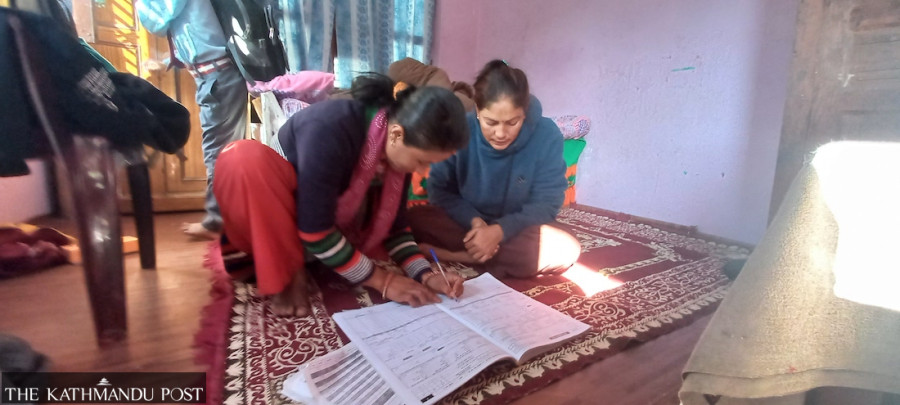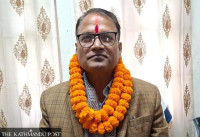National
National census preliminary report on Bajhang comes into question
Local units in the district have accused the government of failing to collect and report factual data.
Basant Pratap Singh
As per the national census held in 2011, the population of Jayaprithvi Municipality in Bajhang district was 22,191 with a total of 4,015 households. With the objective to update the population status of the local unit, the municipality collected data last year by mobilising 14 enumerators in all 11 wards.
The municipality’s count, which was concluded in June 2021, shows that there are a total of 4,733 households with a total population of 28,865 in Jayaprithvi Municipality. The municipality’s census concluded an increase of 718 households and 6,674 people in Jayaprithvi Municipality in the span of 10 years.
However, the preliminary data of the national census, which was made public recently, has stark contradictions. As per the national census 2021, there are 4,088 households with 21,973 people in Jayaprithvi Municipality.
The municipality’s employees claim that there was sheer negligence in the collection of data for the national census as the information collected by the municipality and the Central Bureau of Statistics showed a difference of more than 5,000 heads in Jayaprithvi’s population.
"We were shocked with the population report of the national census. There is a huge difference in the number of households and population collected by the municipality and the national census employees,” said Suman Bogati, the information officer at the municipality. “This is sheer neglect on the part of the government. The mistake should be corrected.”
According to Bogati, he has informed the national census office about the mistake in the census report.
“When I called the national census officer, he said that the population might have decreased as the enumerators did their counting based on the current residence of the people. It could be right in the case of people. But how can there be such a difference in the number of households? He could not even answer why there was such a big difference in the number of households,” said Bogati. He demanded immediate correction of the national census's data as the different levels of government and non-governmental sectors formulate plans and policies on the basis of such data.
Not only Jayaprithvi Municipality but all 12 local units of Bajhang district have their doubts over the national census’s population data of the respective local bodies.
After the local level elections of 2017, the local bodies had visited every household and collected data for the next three years. Their reports bore results different from the ones presented by the national census recently.
The local units are now raising questions over the veracity of the data of the recent census.
“We are surprised because the number of households has decreased by more than 400 and the population dwindled by 6,000 in our local unit within two years. How can there be such a fall in population in such a short period of time? Neither have there been that many deaths to make such a huge difference in the number nor have the local population migrated to other places. The census report sounds like guesswork. It is unbelievable,” said Ramesh Kumar Karki, the information officer of Bungal Municipality. According to him, he tallied the data that the municipality collected two years ago with the records of birth, death and migration over the same time period. “Our study shows that the population is increasing in the municipality,” he asserted. “But the national census shows just the opposite.”
According to the national census of 2011, there were 5,480 households with a total population of 33,224 in Bungal. The municipality’s data collected two years ago shows 5,735 households with a population of 39,550. But the fresh data from the national census shows 5,357 households and 33,487 people.
Mashta Rural Municipality has also questioned the accuracy of the recent national census report. The census data shows different numbers from the one that the rural municipality had collected two years ago with the support of an NGO.
In the door-to-door headcount that the local unit conducted two years ago, there was a total population of 17,909 from 2,798 households in Mashta. But the recent census report says that there are only 13,584 people in 2,519 households.
In comparison to the national census report of 2011, the preliminary report of this year’s census shows a decrease in both household numbers and population in 11 out of 12 local units in Bajhang. In Saipal Rural Municipality of the district, the population has increased to 2,681 from 2,182 in 2011. The household number also increased to 454 from 363 in the last 10 years.
As per the national census 2011, Bajhang had a total population of 195,159 with 33,773 households. The population and household numbers have now decreased to 189,097 and 32,916 respectively.
Several local units in the district have accused the government of failing to collect and report factual data due to procedural mistakes. They allege that enumerators entered data without actually visiting the households. Some of the trained enumerators, as local people claimed, did not go to the field but sent some other people to collect data.
Some enumerators admit that the recent national census has failed to give the actual data.
“We were told that some families and individuals were staying in the district headquarters or other bazaar areas when we visited the village to collect data. We were told to collect data of those who were present in their original addresses. The ones who had moved out of their local units would be counted in the place of their current residence,” said an enumerator deployed to Jayaprithvi Municipality. “We later tried to find out where they were living in the district headquarters but could not find them. I think they were left out in the census report.”
Dirgharaj Pandit, an assistant professor of Population at Jayaprithvi Multiple Campus, says that it is natural to have different data of population, as details of people are taken from their current place of residence and not from their native villages or original addresses.
“But the data of households is quite different. There is a mistake over the number of households,” Pandit said. “The mistakes must be corrected immediately because all government plans and policies will be based on the recent national census and false data will hamper the effectiveness of such plans and policies.”
Dipendra Bohara, an officer at the national census office in Bajhang, admits the possibility of mistakes in the census’s data.
“This is only the preliminary report. There could be mistakes in some figures. It will be corrected in the final report,” he said.




 9.12°C Kathmandu
9.12°C Kathmandu















